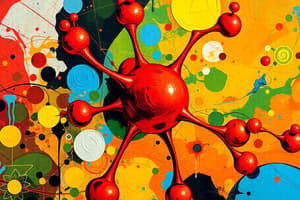Podcast
Questions and Answers
What is a free radical?
What is a free radical?
- A type of antioxidant
- A stable molecule with paired electrons
- An atom or molecule with one or more unpaired electrons (correct)
- A byproduct of mitochondrial respiration
What is the main role of antioxidants?
What is the main role of antioxidants?
- To donate an electron to free radicals (correct)
- To generate reactive oxygen species
- To inhibit free radical formation
- To cause oxidative stress
Which of the following is NOT a source of internally generated free radicals?
Which of the following is NOT a source of internally generated free radicals?
- Peroxisomes
- Environmental pollution (correct)
- Mitochondria
- Phagocytes
What does superoxide dismutase (SOD) primarily do?
What does superoxide dismutase (SOD) primarily do?
What are reactive nitrogen species (RNS)?
What are reactive nitrogen species (RNS)?
Which process do external sources of free radicals NOT initiate?
Which process do external sources of free radicals NOT initiate?
What role does catalase play in cells?
What role does catalase play in cells?
What is the primary effect of oxidative stress?
What is the primary effect of oxidative stress?
Which moment for hand washing occurs after interacting with a patient?
Which moment for hand washing occurs after interacting with a patient?
What is the main purpose of hand washing in a healthcare setting?
What is the main purpose of hand washing in a healthcare setting?
Which type of hand washing is specifically aimed at removing transient organisms?
Which type of hand washing is specifically aimed at removing transient organisms?
Which method should be used for antiseptic hand washing?
Which method should be used for antiseptic hand washing?
Which of the following is NOT a moment for hand washing?
Which of the following is NOT a moment for hand washing?
Flashcards are hidden until you start studying
Study Notes
Free Radicals
- A free radical is an atom or molecule with one or more unpaired electrons.
- This makes free radicals unstable and highly reactive because they tend to acquire electrons from other substances.
Antioxidants
- An antioxidant is a molecule stable enough to donate an electron to a free radical.
- This neutralizes the free radical, reducing its capacity to cause damage.
Pro-oxidants
- Substances that induce oxidative stress, either by generating reactive oxygen species or by inhibiting antioxidant systems.
Oxidative Stress
- An imbalance between the production and accumulation of reactive oxygen species (ROS) in cells and tissues and the ability of the biological system to detoxify these reactive products.
Reactive Oxygen Species (ROS) & Reactive Nitrogen Species (RNS)
- Reactive Oxygen Species (ROS) are reactive chemical species containing oxygen.
- Examples include hydroxyl (OH), hydrogen peroxide (H2O2), superoxide (O2), peroxyl (RO2), and singlet oxygen (O2).
- Reactive Nitrogen Species (RNS) are a group of compounds that include:
- Nitric oxide radical (NO), nitrogen dioxide radical (NO2), peroxynitrite (ONOO-), other oxides of nitrogen, and products arising when NO reacts with O2 and other free radicals.
Sources of Free Radicals
Internally Generated Sources
- Mitochondria
- Peroxisomes
- Phagocytes
- Plasma membranes
- Arachidonate pathways (cyclo- and lipoxygenase)
- Reactions involving iron and other transition metals
Externally Generated Sources
- Ultraviolet rays and radiation
- Environmental pollution
- Cigarette smoking
- Inflammation, drugs, and industrial solvents
Dangerous Effects of Free Radicals
- Free radicals can damage cells and contribute to various diseases, including:
- Cancer
- Heart disease
- Alzheimer's disease
- Parkinson's disease
- Arthritis
Classifications of Antioxidants
- Enzymatic Antioxidants
- Superoxide Dismutase (SOD)
- Dismutates superoxide radicals to form hydrogen peroxide (H2O2) and oxygen (O2).
- First line of defense against free radical formation.
- Three isoforms (SOD1, SOD2, SOD3) are found in mammalian cells.
- Catalase
- Found in nearly all living organisms.
- Decomposes hydrogen peroxide to water and oxygen.
- Protects cells from oxidative damage by ROS.
- Superoxide Dismutase (SOD)
Hand Washing
-
5 Moments for Hand Washing:
- Before touching a patient
- After touching a patient
- After touching a patient’s surroundings
- After touching body fluid
- Before a septic procedure
-
Purpose of Hand Washing:
- Prevent infection
- Remove dust and microbes
- Remove microorganisms
- Protect the patient
- Protect relatives
-
4 Types of Hand Washing:
- Routine Hand Washing:
- Removes transient organisms
- Use warm water
- Antiseptic Hand Washing:
- Uses warm water and antimicrobial soap for 2-3 minutes, covering hands and fingers
- Removes microorganisms and dust
- Routine Hand Washing:
-
Hands Evaluation Before Hand Washing:
- Short cut nails
- No wounds
- No accessories, except a wedding ring
Hand Washing Steps
- Step 1: Wash hands with alcohol
- Step 2: Surgical hand washing before surgical operations
- Step 3: Use 13-5 ml antiseptic solution, covering hands to elbows
- Step 4: Stand in front of the sink
- Step 5: Leave space and bend slightly
- Step 6: Control the water rate
- Step 7: Turn off sleeves to elbow
- Step 8: Wet your hands
- Step 9: Wash from cleanest to least clean areas
- Step 10: Make your hand down
- Step 11: Take some soap then
- Step 12: Rub each thumb clasped in the opposite hand using a rotational movement
- Step 13: Rub tips of fingers in opposing palm in a circular motion
- Step 14: Rub each wrist with opposite hand
- Step 15: Rinse hands with water
- Step 16: Use elbow to turn off tap
- Step 17: Dry thoroughly with a single-use towel
Gloves
- Purpose: Prevent the spread of infection
- Indications:
- Contact with body fluid
- Contact with sterile areas
- Contact with septic procedures
- Types of Gloves:
- Open method
- Closed method
Gloves Removal
- Methods for Gloves Removal:
- Method 1
- Method 2
- Method 3
- Method 4
- Method 5
- Method 6
- Method 7
Studying That Suits You
Use AI to generate personalized quizzes and flashcards to suit your learning preferences.




